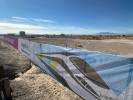Joshua Tree National Park a haven of oases
Joshua Tree National Park, just outside of Twentynine Palms, Calif., is a great springtime destination to visit for a day or two or even an extended trip to hike, go birding or just drive around looking at wildflowers. The park was established as a national monument in 1936 and gained national park status in 1994, and this year, it is celebrating its 75th anniversary.
There are two large desert ecosystems in the 800,000-acre park, thanks to elevations ranging from 536 to 5,814 feet. In the eastern area of the park and below 3,000 feet, you will find the Colorado Desert (part of the Sonoran), where creosote, palo verde, ocotillo and cholla cactus dominate, and in the western section is the Mojave Desert, where the Joshua tree itself can be found in dense concentrations.
Among my favorite places in the park are the five desert fan palm oases. There are only 158 of these oases in the country! The desert fan palm, Washingtonia filifera, is the only palm tree native to western North America. It can grow more than 70 feet tall and thrives only where there is ample water. In this park, the oases are found where geologic fault lines force water to the surface.
Two of the oases are near the park’s main entrance just outside the city of Twentynine Palms. The closest one to visit, if you are traveling from Las Vegas, is the Oasis of Mara behind the Oasis Visitor Center. A short and easy half-mile loop trail gets you up close to the palms. Also easy to reach, a couple of miles’ drive from there, is the 49 Palm Oasis. To see these palms up close, you’ll have to commit to a moderate three-mile, round-trip hike.
The other three oases lie about an hour’s drive away, in the park’s southern region. The drive itself is well worth it. All three oases share the same trailhead, which is well signed, easy to find and located about one mile from the Cottonwood Visitor Center.
The easiest one to get to is the Cottonwood Spring Oasis, less than five minutes on foot. The second one is the Lost Palm Oasis, which boasts the second-largest stand of palms in the park, but you’ll need to be prepared for an eight-mile, round-trip hike. But the most impressive oasis is in Munsen Canyon, one farther than Lost Palm Oasis. This hike is a real adventure, but it’s a challenging one; you will need a good topographical map and route-finding skills. The payoff is worth it, though, as Munsen is home to more than 100 palms, and you’ll get to enjoy them in solitude.
All these palm oases provide wonderful habitat for wildlife. Bighorn sheep and coyotes are frequent visitors. Once in a while during spring migration, a large group of more than 200 turkey vultures stops at the Oasis of Mara overnight, which must be a sight to behold. Also thriving here are smaller species such as the western yellow bat, which roosts here, and hooded orioles, which build their nests under the leaves.
The park offers good birdwatching at all times of year. More than 250 kinds of birds have been recorded in the park, and about 78 species are known to nest here, including Bendire’s thrasher, western kingbird and ash-throated flycatchers. Year-round residents include roadrunner, verdin, Gambel’s quail, Le Conte’s thrasher and birds of prey, such as red-tailed hawk, American kestrel, prairie falcon and great horned owl. Migrating birds of prey often seen include sharp-shinned hawk, northern harrier, osprey and Swainson’s hawk.
You could keep busy here for days or weeks driving more than 80 miles of paved roads and another 81 miles of unpaved roads or hiking some of the 191 miles of foot trails.
The Joshua Tree Visitor Center and the Oasis Visitor Center are open from 8 a.m. to 5 p.m. daily. The Cottonwood Visitor Center is open from 9 a.m. to 3 p.m. daily. Joshua Tree National Park is about 210 miles south of Las Vegas, depending on which route you take.
Deborah Wall is the author of “Great Hikes, A Cerca Country Guide” and “Base Camp Las Vegas: Hiking the Southwestern States,” published by Stephens Press. She can be reached at deborabus@aol.com.


















